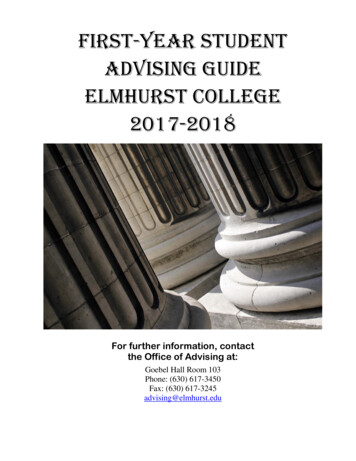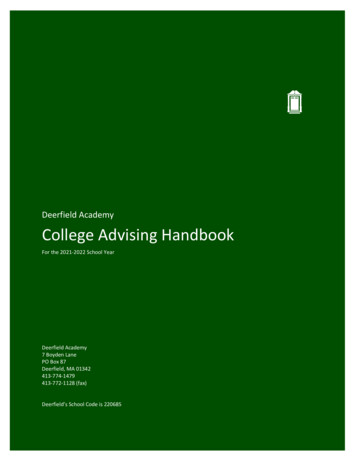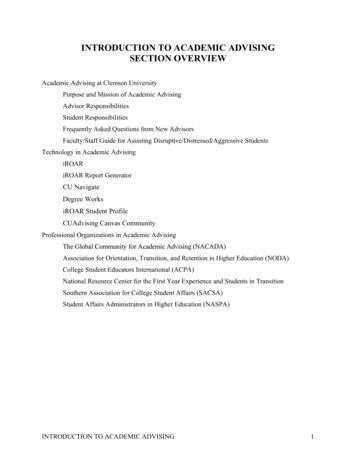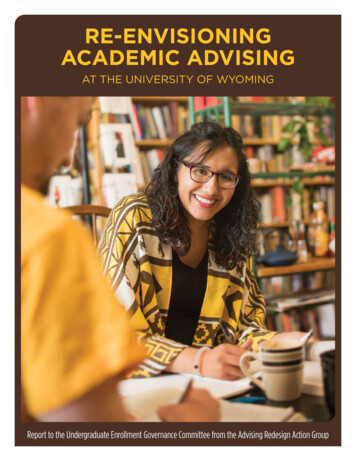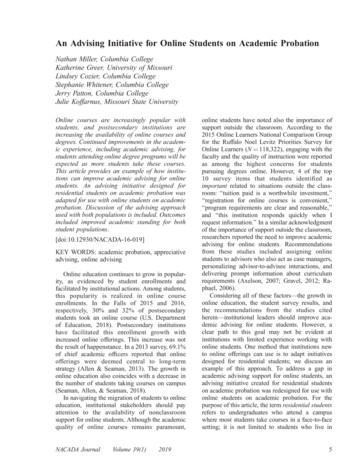
Transcription
An Advising Initiative for Online Students on Academic ProbationNathan Miller, Columbia CollegeKatherine Greer, University of MissouriLindsey Cozier, Columbia CollegeStephanie Whitener, Columbia CollegeJerry Patton, Columbia CollegeJulie Koffarnus, Missouri State UniversityOnline courses are increasingly popular withstudents, and postsecondary institutions areincreasing the availability of online courses anddegrees. Continued improvements in the academic experience, including academic advising, forstudents attending online degree programs will beexpected as more students take these courses.This article provides an example of how institutions can improve academic advising for onlinestudents. An advising initiative designed forresidential students on academic probation wasadapted for use with online students on academicprobation. Discussion of the advising approachused with both populations is included. Outcomesincluded improved academic standing for bothstudent populations.[doi:10.12930/NACADA-16-019]KEY WORDS: academic probation, appreciativeadvising, online advisingOnline education continues to grow in popularity, as evidenced by student enrollments andfacilitated by institutional actions. Among students,this popularity is realized in online courseenrollments. In the Falls of 2015 and 2016,respectively, 30% and 32% of postsecondarystudents took an online course (U.S. Departmentof Education, 2018). Postsecondary institutionshave facilitated this enrollment growth withincreased online offerings. This increase was notthe result of happenstance. In a 2013 survey, 69.1%of chief academic officers reported that onlineofferings were deemed central to long-termstrategy (Allen & Seaman, 2013). The growth inonline education also coincides with a decrease inthe number of students taking courses on campus(Seaman, Allen, & Seaman, 2018).In navigating the migration of students to onlineeducation, institutional stakeholders should payattention to the availability of nonclassroomsupport for online students. Although the academicquality of online courses remains paramount,NACADA JournalVolume 39(1)2019online students have noted also the importance ofsupport outside the classroom. According to the2015 Online Learners National Comparison Groupfor the Ruffalo Noel Levitz Priorities Survey forOnline Learners (N ¼ 118,322), engaging with thefaculty and the quality of instruction were reportedas among the highest concerns for studentspursuing degrees online. However, 4 of the top10 survey items that students identified asimportant related to situations outside the classroom: ‘‘tuition paid is a worthwhile investment,’’‘‘registration for online courses is convenient,’’‘‘program requirements are clear and reasonable,’’and ‘‘this institution responds quickly when Irequest information.’’ In a similar acknowledgmentof the importance of support outside the classroom,researchers reported the need to improve academicadvising for online students. Recommendationsfrom these studies included assigning onlinestudents to advisors who also act as case managers,personalizing advisor-to-advisee interactions, anddelivering prompt information about curriculumrequirements (Axelson, 2007; Gravel, 2012; Raphael, 2006).Considering all of these factors—the growth inonline education, the student survey results, andthe recommendations from the studies citedherein—institutional leaders should improve academic advising for online students. However, aclear path to this goal may not be evident atinstitutions with limited experience working withonline students. One method that institutions newto online offerings can use is to adapt initiativesdesigned for residential students; we discuss anexample of this approach. To address a gap inacademic advising support for online students, anadvising initiative created for residential studentson academic probation was redesigned for use withonline students on academic probation. For thepurpose of this article, the term residential studentsrefers to undergraduates who attend a campuswhere most students take courses in a face-to-facesetting; it is not limited to students who live in5
Miller et al.Table 1. Residential and online student demographicsDemographic CategoryAge (average years)Gender (%)Race (%)Academic load (%)CharacteristicMaleFemaleWhiteBlack or African AmericanOtherFull-timePart-timeLive in campus housing (%)Residential Students22435774422841638Online Students32396159221927730Note. Full-time ¼ 12 or more hours per semester; Part-time ¼ fewer than 12 hours per semester.college-provided housing. The term online studentsrefers to those who exclusively take online coursesand receive advising through e-mail and phonefrom a centralized advising center.SettingThe setting for the study was a private, liberalarts, nonprofit, master’s degree–granting college inthe Midwest. The college comprises studentsattending courses in three distinct venues: approximately 1,000 students who attend a residentialcampus, 10,000 students who attend evening andonline courses through a system of nationwidelocations, and 3,000 students who attend coursessolely online.The institution provides courses for earnedcredit through a variety of delivery methods (faceto face, online, and a hybrid delivery combination),term lengths (8- or 16-week sessions), class lengths(once per week for 4 hours, three times per weekfor 55 minutes per meeting, or asynchronousonline), and geographic locations. The residentialand online student demographics at the enrollmentinstitution differ. Residential students tend to betraditional-aged undergraduates, and online students tend to be of nontraditional age. Table 1presents the demographic information for the twostudent groups.The variety of educational offerings and delivery methods at the institution prompted a generalquestion: Can student support initiatives deemedbeneficial for students in one setting be redesignedand successfully implemented with students inanother setting? This query was investigated whenthe administrators redesigned an advising initiativefor residential students on academic probation foruse with an online student population on academicprobation.6Student Persistence Models and AdvisingApproachesThe foundations for the advising initiativesdiscussed herein include three student persistencemodels and two advising approaches. The studentpersistence models referenced are a model ofnontraditional student attrition (Metzner & Bean,1987), a model of dropout from distance educationcourses (Kember, 1989), and a model of collegestudent persistence (Milem & Berger, 1997). Thesemodels include academics as student persistencefactors.Proactive and appreciative advising approacheswere used to develop the advising initiatives.Proactive advising is based on intrusive counseling, which relies on counselor-initiated contacts(Glennen, 1975). Varney (2012) explained thatproactive advising can be employed through acommunication plan with students, and the advising initiatives in this study were designed with acommunication plan. The content of the proactivecommunications for the residential and onlineinitiatives was built on appreciative advisingstages. The appreciative advising framework wasdeveloped in the early 2000s on the basis ofpositive psychology, appreciative inquiry, choicetheory, reality therapy, social constructivist theory,scaffolding, and zone of proximal developmentapproaches (Bloom, Hutson, & He, 2008). Thepractice of appreciative advising relies on astudent-advisor cocreated student developmentpath designed according to the student’s strengthsand is fostered through regular advisor and studentcontact (Bloom et al., 2008).The relationship of proactive and appreciativeadvising to developmental advising warrantsexplanation. Winston, Miller, Ender, and Grites(1984) codified the tenets of developmentaladvising in Developmental Academic Advising.NACADA JournalVolume 39(1)2019
Initiative for Online StudentsThe developmental approach requires a closestudent-advisor relationship that focuses on achieving both the academic and the personal goals of thestudent. Grites (2013) later recognized a commonthread through proactive, appreciative, and developmental advising: All three approaches use adevelopmental approach to help students reachtheir goals.Literature ReviewThe advising initiatives outlined in this articlerelied on several aspects of advising at the collegeunder study: using proactive and appreciativeadvising approaches, advising online students,and improving the academic performance ofstudents on academic probation. Therefore, wereviewed studies related to these areas.Proactive and Appreciative AdvisingStudies that examined proactive (intrusive)advising, or related methods, have revealedpositive outcomes for students who presentedwith academic risk factors, such as low gradepoint averages (GPAs) or academic probationstatus (Abelman & Molina, 2002; Kirk-Kuwaye& Nishida, 2001; Molina & Abelman, 2000). Inaddition, Bettinger and Baker (2011) tracked theacademic progress of 13,555 students at eighthigher education institutions and reviewed theeffectiveness of outreach provided to 8,049 ofthose students. In their study, an institutionalrepresentative contacted students to discussbarriers to success. The authors found thisapproach (called ‘‘coaching’’ in their article) tobe effective for 6-, 12-, 18-, and 24-monthretention at a more than 99% confidence intervaland degree completion at a more than 90%confidence interval. In contrast to these findings,Schwebel, Walburn, Klyce, and Jerrolds (2012)reported no significant changes in retention orstudents’ academic progress when an advisingapproach related to proactive advising (advisorsmade outreach but students were not required toattend advising sessions) was used with a generalstudent population.Appreciative advising resources include methodologies, reports on advisor and student perceptions of the approach, and recommendations foruse in orientation courses and advising sessions.Hutson and Clark (2007), as cited in Bloom et al.(2008), reported that an appreciative advisingapproach increased the GPAs and persistencelevels of students returning from academicdismissal. However, the sample size for thisNACADA JournalVolume 39(1)2019report was small (N ¼ 12), and the threshold forthe statistical significance of the change in GPAswas not provided. Hutson (2010) later reportedthat the use of an appreciative advising approachin a first-year experience course with moreparticipants (N ¼ 679) than in the 2007 Hutsonand Clark study positively affected participantGPA, retention, and responses to precourse andpostcourse academic self-efficacy surveys. Pulcini (2016) suggested that using appreciativeadvising could promote degree completion bywomen of Appalachia, but the article did notinclude student outcome data. Other reports onstudent and advisor feedback on appreciativeadvising sessions indicated that participantsvalued the approach. For example, Truschel(2008) administered a student survey and reported that students on academic warning respondedpositively to appreciative advising sessions. Inaddition, Howell (2010) conducted a qualitativestudy of advisors’ perceptions of appreciativeadvising and concluded that the strategy allowedadvisors to be more effective.Advising Online StudentsAuthors have provided guidance for advisingonline students, including practical advice. Forexample, Redfern (2008) discussed the use of emailed questions to online students to movestudents through appreciative advising stages. Inaddition, Waldner, McDaniel, and Widener(2011) provided tips on the technology neededto advise online students and discussed thelimitations of advising from a distance.Along with practical suggestions from authorson ways to advise online students, students haveidentified the need for improved academicadvising. For example, in a survey of 1,154undergraduates taking online classes, Axelson(2007) determined that advising needed to beimproved and made available online. In a similarstudy, Raphael (2006) surveyed 272 undergraduate and graduate students seeking online degrees. Two of the top five areas needing attention,as reported by students, fell within the purview ofacademic advising. In addition, according tofindings from a mixed-methods study of onlinestudent preferences, Gravel (2012) argued thatcolleges and universities should make academicadvising for online students developmental innature.7
Miller et al.Academic Performance of Students onAcademic ProbationReports on interventions, recommendationsfor advising students on academic probation,and summaries of the characteristics and perceptions of students placed on academic probationare featured in the literature. For example,Lindsay (2000) provided a summary of academicintervention methods used at 11 colleges anduniversities. The researcher reported that successful programs for students at risk academicallywere, among other traits, mandatory and institutionalized.Researchers also reviewed programs intendedto increase the retention of students on academicprobation. Kamphoff, Hutson, Amundsen, andAtwood (2007) used empowerment models toimprove the academic standing of students placedon academic probation. The authors reported thatfocusing on four areas—personal responsibility,positive affirmations, goal setting and life planning, and self-management—resulted in a higherpercentage of students eligible to return fromacademic probation and increased academicachievement (p ¼ .036). Preuss and Switalski(2008) reported that more students on academicprobation who met with academic advisors threeor more times improved their GPA whencompared to students who met only once or notat all with an advisor (p. 6). In addition, Cruise(2002) provided a summary of the steps to takewhen advising a student on academic probation.Additional studies reported on the characteristics,experiences, and perceptions of this studentpopulation (Arcand & LeBlanc, 2011, 2012).The advising initiatives for students onacademic probation that we explored were relatedto the research reviewed and presented herein. Wemeasured outcomes by investigating the impacton students’ academic standings and GPAs.Advising Initiative for Residential Students onAcademic ProbationPrior to the Spring of 2014, no prescribedsupport was available for students placed onacademic probation at the institution we investigated. Students attending the residential campuswho were placed on academic probation receivedletters with information about their probationarystatus and notices that they would be suspended ifthey did not raise their GPAs. Initial analysis in theFall of 2013 revealed that a high percentage ofstudents warned (.48%) were suspended the termafter the probation notifications.8In the Spring of 2014, the residential studentsplaced on academic probation were required toparticipate in advising appointments that focusedon their academic success. The students whoenrolled after they were placed on academicprobation had access to the advising, which wasdesigned to reduce the number of students whowere subsequently suspended from the institutionfor failing to improve their GPAs.The college advisors who facilitated the sessions attended appreciative advising training. Theyused the six stages of appreciative advising—disarm, discover, dream, design, deliver, and don’tsettle—to structure the student meetings (as perBloom et al., 2008), as presented in Table 2. Inaddition, materials developed by the University ofSouth Carolina Student Success Office, includingan About Me form, were adapted for use in theseadvising sessions.Each student placed on academic probation wasrequired to meet with an advisor during the first 2weeks of the semester. In that meeting, the studentcompleted an overview of his or her academicprobation status, an advising agreement, an AboutMe survey, an academic history exercise, andprompts to identify goals for academic success anda student success plan. Each student was theninstructed to meet with the advisor at least twomore times during the semester. The content of thesecond and third meetings was dependent onstudent-identified obstacles. These meetings couldcover a number of topics, such as determining thereason that the student is in college, developingconcrete academic goals, identifying academicstrengths and areas needing improvement, creatinga plan for meeting with professors, and learningabout financial aid needs and options. In addition,a majority of students completed a time-management exercise and a learning-styles inventory.We measured outcomes of the residentialadvising initiative by within-group and yearover-year comparisons. Students were groupedby completion status—they attended the threerequired meetings or attended fewer than threemeetings—and their academic status the semesterfollowing the probation action—off probation,continued probation, suspended, or withdrewfrom courses. We used the within-group analysesto compare the academic statuses and thejuxtaposed postterm GPAs of students on thebasis of attendance at the advising sessions. Weused the year-over-year comparison to investigatedifferences in the academic status of studentsplaced on academic probation before and afterNACADA JournalVolume 39(1)2019
Initiative for Online StudentsTable 2. Alignment of sessions to appreciative advising stagesAppreciativeAdvising StageDisarmTopicOverview ofprobation statusMeeting1stAbout Me survey1stDiscoverAcademic history1stDiscoverGoals foracademicsuccess1stDreamStudent successplan1stDesignProgress check2ndDeliverProgress checkand planningfor subsequentsessions3rdDon’t settleDetail of AlignmentThis meeting opens the door for the advising.The advisor makes a self-introduction andlets the student know that this should not bean overwhelming experience.The advisor learns more from the student fromthe About Me survey, such as the student’sbackground, study habits, support systems,and financial situation.The advisor asks questions to get to know thestudent, including academic behaviors. Thisprobing encourages the advisor to create afoundation for working with the student. Theadvisor can learn the motivations of thestudent to attend college and the student’sconcerns.The advisor works with the student to identifygoals for the semester and helps the studentmake the connection between actions duringthe semester and academic goals.The advisor shares resources and providesfeedback as action plans are createdaccording to the student’s strengths and areasof improvement.The advisor continues to motivate andencourage the student to keep workingtoward initial goals.After gauging progress for the first portion ofthe semester, the advisor works with thestudent to set higher expectations andchallenges the student to ‘‘raise the bar’’(increase expectations).aSource. Appreciative advising stages from Bloom, Hutson, and He (2008).aBloom et al. (2008, p. 98).implementation of the advising initiative. Bothgroups (preimplementation and postimplementation) were composed of students who started aFall or Spring semester as a residential student onacademic probation or continued probation. Weconsidered the outcome of Summer courses forstudents in a postimplementation Spring cohort,as students might take Summer courses toimprove academic standing before the Fallsemester. For the preimplementation group, wereport the outcomes for residential students whoenrolled with a probationary status the Fall orSpring semester after the probation action. For thepostimplementation group, we report the outcomes for students who were required to attendNACADA JournalVolume 39(1)2019advising sessions. The postimplementation groupwas not limited to the Fall or Spring semestersimmediately following the probation action. Thedifference in the parameters for the pre- andpostimplementation groups is a result of therequirement that postimplementation residentialstudents attend advising sessions no matter howlong they waited to reenroll after being placed onacademic probation. The variables, statisticalmethods, and null hypotheses for each test arepresented in Table 3.Results for Residential StudentsThe number of advising sessions a residentialstudent attended affected the student’s academic9
Miller et al.Table 3. Comparison groups, variables, statistical methods, and null hypotheses for the evaluation of theadvising initiative for residential studentsGroupWithinWithinIndependentDependent VariableVariablesTestTwo-tailed,Academic status 1 term Attended 3 or moretwo-sampleadvising sessions;after being requiredproportionattended fewer than 3to attend appreciativetestsadvising sessionsadvising sessionsPostterm GPANull HypothesisThere is no difference inthe proportion ofstudents in eachacademic status forstudents who attended 3sessions and forstudents who attendedfewer than 3 sessions.There is no difference inthe postadvising GPAsof students whoattended 3 sessions andthe postadvising GPAsof students whoattended fewer than 3sessions.There is no difference inthe proportion ofstudents in eachacademic status beforeand after theimplementation of theadvising initiative.Two-sampleAttended 3 or moret testadvising sessions;attended fewer than 3advising sessionsYear-over- Academic status 1 term Preimplementation;postimplementationyearafter being placed onacademic probation(preimplementationgroup) or 1 termafter being requiredto attend appreciativeadvising mpleproportiontestsNote. GPA ¼ grade point average.Table 4. Within-group comparison of academic status for residential students on academic probation whowere required to attend appreciative advising sessions, Spring 2014–Spring 2016StatusOff probationAttended fewer than 3 sessionsAttended 3 or more sessionsContinued probationAttended fewer than 3 sessionsAttended 3 or more sessionsSuspendedAttended fewer than 3 sessionsAttended 3 or more sessionsWithdrew from coursesAttended fewer than 3 sessionsAttended 3 or more sessionsStudentsSummaryTotal CohortRate (%)Significance 45.523.9.0182244714.52.8.641Note. Two-tailed, two-proportion tests used for significance.10NACADA JournalVolume 39(1)2019
Initiative for Online StudentsFigure 1. Academic status of residential students on academic probation who were required to attendappreciative advising sessions Spring 2014–Spring 2016status and GPA. More students who attended threeor more sessions (59.2%) were removed fromprobation compared to students who attendedfewer than three sessions (29.5%). This differencewas significant (p ¼ .001). Fewer students (23.9%)who attended three or more sessions weresuspended compared to those students whoattended fewer than three sessions (45.5%). Thisdifference was also significant (p ¼ .018). Wefound other differences in the academic statuses ofthe two groups, but these were not significant.Table 4 shows the results of the two-tailed, twosample proportion tests for the within-groupanalyses, and Figure 1 presents the comparisonsof academic statuses.A two-tailed, two-sample t test was conducted tocompare the postterm GPAs of students whoattended three or more sessions to those whoattended fewer than three sessions. A significantdifference was found between the postterm GPAsof students who attended three or more sessions (M¼ 1.875, SD ¼ 0.427) and the postterm GPAs ofstudents who attended fewer than three sessions (M¼ 1.489, SD ¼ 0.661); t(63) ¼ 3.42, p ¼ .001.Differences also emerged in the year-over-yearanalysis of academic status. The proportion ofstudents removed from probation significantlyNACADA JournalVolume 39(1)2019increased from 20.5% to 47.8% after the advisinginitiative was implemented (p ¼ .001). Table 5features the results of the two-tailed, two-sampleproportion tests for the year-over-year analysis ofacademic status, and Figure 2 shows the academicstatuses for students before (Fall 2012–Fall 2013)and after (Spring 2014–Spring 2016) the advisinginitiative was implemented.Advising Initiative for Online Students onAcademic ProbationDespite the implementation of the residentialadvising initiative described herein, a standardoutreach plan for online students on academicprobation did not exist at the institution. Initialanalysis revealed that a high percentage of onlinestudents were suspended one term after beingplaced on academic probation (.45%). Collegeadministrators decided to adapt the residentialinitiative for use with online students.Academic advisors for online students (onlineadvisors) created a proactive outreach plan on thebasis of the residential advising initiative. Theseadvisors were chosen to create the online versionbecause they had the best understanding of onlinestudents’ needs and preferences at the institution.To complete this plan, the advisors considered11
Miller et al.Table 5. Year-over-year comparison of academic status before (Fall 2012–Fall 2013) and after (Spring2014–Spring 2016) implementation of an appreciative advising initiative for residential studentson academic probationStatusOff probationFall 2012–Fall 2013Spring 2014–Spring 2016Continued probationFall 2012–Fall 2013Spring 2014–Spring 2016SuspendedFall 2012–Fall 2013Spring 2014–Spring 2016Withdrew from coursesFall 2012–Fall 2013Spring 2014–Spring 2016StudentsSummaryTotal CohortRate (%)Significance 1548.732.2.069543911512.83.5.096Note. Two-tailed, two-proportion tests used for significance.differences between the residential and onlineacademic environments: the length of terms (16weeks for residential and 8 weeks for onlineterms), the maximum concurrent hours allowed perstudent per term (18 hours for residential and 6 foronline students), the delivery method (face to facefor residential and asynchronous for online students), availability of academic support such astutoring, and the geographical proximity of students to their advisors. The result of the adaptationFigure 2. Year-over-year comparison of academic status before (Fall 2012–Fall 2013) and after (Spring2014–Spring 2016) implementation of appreciative advising initiative for residential studentson academic probation12NACADA JournalVolume 39(1)2019
Initiative for Online StudentsTable 6. Alignment of communications topics sent to online students to appreciative advising etail of AlignmentOverview of probation1stDisarmThis communication opens the door for thestatusadvising. The advisor makes an introductionand lets the student know that this should notbe an overwhelming experience.Questions about1stDiscoverThe advisor asks questions to prompt thoughtstudent-identifiedon the student’s own academic behaviors. Theproblemsstudent starts to codify motivations forattending college and any concerns about thefuture.Suggestions for course1stDiscoverThe advisor learns more from the student andloads and coursethe student identifies potential areas ofretakesconcern.Goals for academic2ndDreamThe advisor encourages the student to identifysuccessgoals for the semester and reasons forpursuing a degree. The advisor can help thestudent make the connection between actionstaken during the semester and academicgoals.Links to academic2ndDesignThe advisor shares resources and providesresourcesfeedback as action plans are created based onthe student’s strengths and areas of neededimprovement.Progress check2ndDeliverThe advisor continues to motivate the student tokeep working toward the initial goals.Progress check3rdDon’t Settle After gauging progress for the first portion ofthe semester, an advisor can work with thestudent to set higher expectations, andchallenge the student to ‘‘raise the bar.’’aSource. Appreciative advising stages from Bloom, Hutson, and He (2008).Note. aBloom et al. (2008, p. 98).was a communication strategy comprising threescheduled, proactive outreach efforts via e-mail andphone calls. The length of online courses and theinability to ensure advisor availability whenstudents were likely available (most online studentswere thought to be working adults, and theacademic advisors held limited hours after 5:00p.m.) resulted in different parameters for onlinestudent participation. Unlike the required meetingsfor residential students, the online initiative wascomposed of no-risk, no-reward communications;neither a response nor a lack of response hadpositive or negative consequences for students.Appreciative advising was chosen as thescaffold for the online student communication planbecause the approach had been used with residential students. The online advisors developed topicsNACADA JournalVolume 39(1)2019in the communication strategy that were alignedwith the six appreciative advising stages (see Table6). The first communication was sent by e-mail tostudents on academic probation the week before orthe first week of the term. This e-mail included ashort explanation of academic probation; questionsprompting students to identify possible barriers totheir academic success, such as test taking, paperwriting, and time management; links to collegeresources for the topics listed herein; suggestionsfor a reduced course load; and a question askingstudents to consider the courses they may retake toimprove their academic standing.The second communication was a phone callbefore midterm exams. Advisors checked studentactivity in the learning management system andthen called the students to discuss their progress.13
Miller et al.Advisors sent e-mails to students whom they couldnot reach by phone. Information discussed included a GPA projection worksheet, a student successplan adapted from the form used with residentialstudents, an offer of assistance in formulating anacademic success plan, and a set of links toacademic resources. The third communication wasa phone call in the 6th or 7th week of the 8-weekterm. As with the midterm phone call, advisor
academic advising support for online students, an advising initiative created for residential students on academic probation was redesigned for use with online students on academic probation. For the purpose of this article, the term residential students refers to undergraduates who attend a campus where most students take courses in a face-to-face

